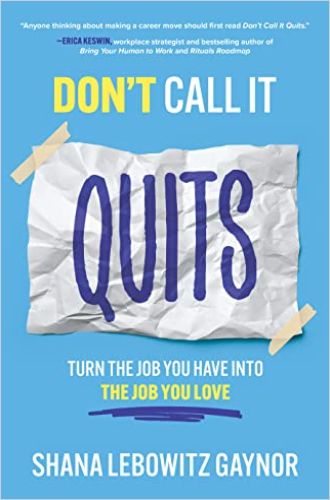“Feeling Stuck Is Something Many of Us Have Experienced”

Shana, when looking at business books from the last years, there’s a trend in many books suggesting to their readers that they can and should find their dream job and achieve fulfillment if they only “Start with Why,” for example. There are hundreds of other “strategies” that sound appealing and straightforward, yet I’ve spoken with many people who feel pressured by them.
Interestingly, you had a similar experience to mine, both as someone who reads such books and as someone who covered careers, workplace dynamics, and HR at Business Insider.
Exciting. These people’s stories usually have in common that they constantly strive to match the ideals these books set for their jobs, but most don’t succeed – and it drains them. Is Don’t Call It Quits a response to the trend and these books?
I believe Don’t Call It Quits partly responds to the “cultural ethos” that inspired some of the titles you mentioned. Specifically, there’s an idea that many of us buy into: If you’re unhappy at your job, you should leave and find a job that brings daily happiness, fulfillment, and meaning. This advice can be suitable for specific individuals at certain career stages. However, my book offers a different perspective because that advice doesn’t apply to a lot of people. Finding a new job that matches your current pay, benefits, or flexibility can be very challenging.
My book encourages readers and professionals to find greater happiness at their current workplace – with an approach that doesn’t require radical changes.
Yet, feeling stuck in one’s career seems to be a pretty common thing these days. Many employees feel they must quit to make a change. Can you share some stories that embody this specific feeling?
Certainly, feeling stuck is something many of us have experienced in our professional lives. You might feel out of control, like you don’t know where your career is going and you’re not equipped to direct it to the next stage. One story I often refer to is based on an interview with Dean Carter, former Head of Global People & Culture at Patagonia and currently Chief People and Culture Officer at Guild Education, headquartered in Denver. Dean was at Sears before Patagonia, and the company was struggling financially. The workplace environment wasn’t great, and he managed HR professionals who also felt stuck and unmotivated. Dean likened their situation to being a band on the Titanic – the ship was sinking, but they were determined to make the most of the experience. He advised his team to focus on becoming exceptional HR professionals so that they could develop the skills and experience that would help them get their next roles.

This approach involves maintaining your current job but shifting your mindset.
It’s a great way to get “unstuck” because you’re not really changing your behavior.
This concept of job crafting has been around for a while, and most HR professionals are familiar with it. However, many companies maintain strict job descriptions and limited career path options despite its prevalence. Why do organizations hesitate to adopt a more agile approach and encourage employees to co-design their job profiles for better engagement and retention?
While some organizations explicitly encourage job crafting, most employers don’t. I can’t say for sure why employers would be reluctant to do that.
However, I believe many employers tend to view employees as primarily focused on their own interests.
So maybe they feel that if they gave employees the time and space to codesign their jobs, people would just do whatever they wanted.
Do you disagree with that?
I’m disinclined to believe that encouraging job crafting would result in chaos. Job crafting is often associated with benefits like increased retention and engagement.
While retaining talent is vital, what other advantages should companies consider?
Organizations can also benefit from encouraging their employees to job-craft. When we think of job crafting, we often imagine employees making substantial overhauls to their roles. But when I spoke with Amy Wrzesniewski, a professor at Yale who pioneered research on job crafting, I learned that it can involve micro-tweaks to your job. For instance, employees could experiment with new ways of serving clients or collaborate with another team.
Yet, it seems to require a guiding force. Who should take the lead in encouraging employees to adopt job crafting? Is it HR, team leaders, or someone else?
That is an essential question; I’m glad you brought it up.
While ideally, HR and talent management teams would spearhead the effort, more realistically team leaders, especially middle managers, facilitate job crafting. They can be role models by telling employees when they’re in the process of crafting their own jobs.
They can say, “I’m going to this meeting now or I’m pulling back on this project. And the reason why is because I’m trying something that I think would be great for our team and great for me personally.”
After all, companies emphasize they’re desperately seeking ‘impact players’ these days – opening up ways for their people to demonstrate their talent would be a vital sign that they are serious about it. On the other hand, for employees who feel stuck or unfulfilled in their roles, where should they begin if they want to initiate job crafting and improve their situation?
One piece of advice I received from Gretchen Rubin of the Happiness Project is to identify the specific issue causing your dissatisfaction. While it may seem like your entire work experience is the problem, it’s more likely that there’s a more specific problem. Maybe you have a long commute, an annoying co-worker, or a particularly frustrating project. Pinpointing the exact issue makes it easier to address and improve upon. Another practical approach comes from Shannon Sullivan, who’s now the Chief People Officer at Dave, a fintech company. She introduced a “trigger and action list,” which breaks down complaints or triggers into actionable steps.
How does it work?
Every time something bothers you at work, write it down as a trigger and then detail an action you can take to address it. Sometimes, even beyond your specific action, you realize you can do something about this. Another idea is based on research on “fit” and “develop” mindsets from Patricia Chen, who’s now an assistant professor at the University of Singapore.
Can you quickly lay out the differences and why it is essential?
Many Americans lean towards the “fit” mindset, seeking a job that perfectly aligns with their personality and skills. If you have a “develop” mindset, you believe that there are many jobs you could take and get used to so that over time, it becomes a job that suits you. Interestingly, Chen’s research found that people with either mindset achieve similar outcomes in terms of job satisfaction and income. This implies that the belief that a job must be ideally suited from the start isn’t necessarily accurate. Overall, understanding that you can evolve and adapt within a role can be quite liberating, even if it doesn’t seem tailor-made.
While it might be challenging to shift your mindset entirely, remembering that the ‘fit’ or ‘develop’ mindset doesn’t significantly influence outcomes can help alleviate pressure.
Yet, your book emphasizes the “develop” mindset as a key to success within a job role. Could you provide more insights into how adopting it can be transformative for individuals striving to make their work more fulfilling?
This mindset shift can be incredibly liberating because it means you’re not bound to the initial conditions of a job. Instead of waiting for the perfect fit, you can actively take steps to shape your role into something more fulfilling. It might involve small changes initially, such as modifying tasks, collaborating differently, or approaching projects from a fresh angle – but it doesn’t have to end there. By acknowledging that roles can evolve, adapt, and even be reshaped to better suit you, you take ownership of your work experience.
About the Author
Shana Lebowitz Gaynor is a journalist at Business Insider, covering careers, leadership and the future of work.






